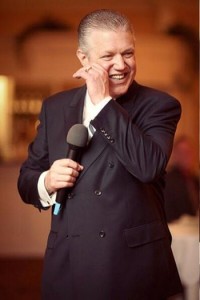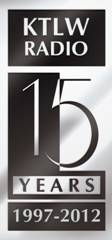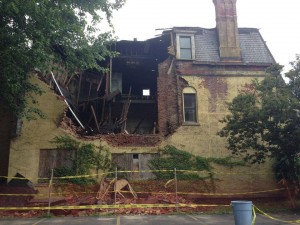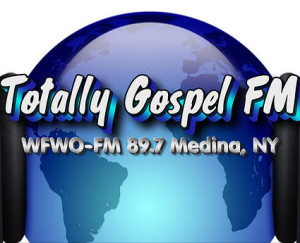NorthEast Radio Watch 12/8/2025: Cichon’s Back in Buffalo
In this week’s issue… Veteran newsman returns - Remembering NY's Leitner, RI's Jones - CT AM saved - Maine AM moves - "Indie" adds suburban signals
In this week’s issue… Albany’s “BobFather” remembered – NYC morning host out – Translator granted in Manhattan – WAWZ expands eastward – NH college station saved
By SCOTT FYBUSH
*Radio managers these days have a tendency to come and go, shifting from market to market at the whims of the corporations that own most of their stations. But in Albany, NEW YORK, Bob Ausfeld was a shining counterexample, and his loss is being dearly felt all over the Capital District radio scene and far beyond.

The news of Ausfeld’s death in Boston at age 64 was just breaking as we were wrapping up the column last Sunday night, so we weren’t able to give the “BobFather” the full consideration he deserved in that issue. Let’s try to rectify that, shall we?
It’s not every radio manager who gets a website tribute from one of the morning guys at the competing cluster – but Bob Ausfeld wasn’t every radio manager, not by a long shot. At the age of 23, fresh out of Hudson Valley Community College and a stint in the National Guard, Ausfeld went to work at WPTR (1540), and for 41 years he never left the Albany radio scene. Within a decade of his start in radio, Ausfeld was already in a general manager’s chair, starting in the late 1970s at WFLY (92.3), then moving in the 1980s to WABY (1400)/WWOM (100.9, which he soon flipped to “K-Lite” WKLI), After a brief detour to Utica in the late 1980s, Ausfeld landed with Merv Griffin-owned WPYX (106.5) in the early 1990s. Over the next few decades, Ausfeld stayed put while a swirl of owners and an ever-changing constellation of stations swirled around him; when the dust finally settled, he found himself working for WPYX’s erstwhile sister station WGNA (107.7) and the cluster that ended up with Regent and then Townsquare.
Along the way, Ausfeld nurtured the careers of hundreds of radio people, launching iconic shows such as Wolf and Mulrooney and Mason and Sheehan (both on WPYX) and Sean and Richie (on WGNA, which is where Sean fondly remembered Ausfeld in a blog posting last week). But it wasn’t just the star morning shows that benefited from the careful attention of “The King,” who mentored air talent and behind-the-scenes staffers who have gone on to populate most of the stations in town and many more in distant markets.
Ausfeld briefly retired in 2012, but radio was still in his blood, and he came back to the GM chair last year at Pamal’s Albany Broadcasting group, where he was busy building a country competitor to WGNA when heart disease took him out of the picture. A donor heart for transplant finally came through over the July 4 holiday, and it was during the touch-and-go days after the surgery that Ausfeld died last Sunday.
Given the immense influence Ausfeld had on the market, it’s no surprise that Albany’s broadcasters came together last Monday morning for a market-wide minute of silence at 8 AM. Calling hours for Ausfeld will be held Tuesday from 4 to 8 PM at St. John the Evangelist in Schenectady, with a funeral Mass to be held there Wednesday morning at 11.
[private]
 *It’s been a rough few years for Long Island’s WLIR (107.1 Hampton Bays), which has slalomed through a succession of unsuccessful formats since its 2011 sale to Livingstone Radio. It was Christian (as “Hope Radio”), then sports (“Champions Radio”), then back to an earlier simulcast with New York’s ESPN outlet, WEPN, then back to “Hope Radio” – and now it’s headed to a new Christian format.
*It’s been a rough few years for Long Island’s WLIR (107.1 Hampton Bays), which has slalomed through a succession of unsuccessful formats since its 2011 sale to Livingstone Radio. It was Christian (as “Hope Radio”), then sports (“Champions Radio”), then back to an earlier simulcast with New York’s ESPN outlet, WEPN, then back to “Hope Radio” – and now it’s headed to a new Christian format.
Starting next month, WLIR will enter into an LMA with Pillar of Fire’s WAWZ (99.1 Zarephath NJ), which will turn 107.1 into a Long Island version of the successful “Star” Christian hits format that’s on the New Jersey signal.
“Star 107.1” will be heard not only on the main Hamptons class A signal, but also on the network of translators that have been carrying “Hope”: W235BB (94.9 Hauppauge), W243BF (96.5 Shirley), W245BA (96.9 Manorville), W268AN (101.5 Plainview) and W283BA (104.5 Selden). The August 1 flip to “Star” will leave Mets fans out on eastern Long Island hanging, since the “Hope” stations had been extending the Mets network eastward from flagship WOR (710 New York).
*In the Meadowlands, Univision’s WADO (1280 New York) is getting ready for some tower work. Back in 2000, WADO replaced its old Blaw-Knox tower #1 with a new self-supporter and added two new short self-supporters to increase its power to 50 kW daytime. But one piece of the old WADO array remained in place: the 220-foot tower #2 on the east side of the array. Now that tower, which dates to the early 1940s, is being replaced with a newer version, and while the work is underway starting today, WADO will operate non-directionally with 12.5 kW days and 1800 watts at night.
Last fall, Luis Jimenez celebrated 20 years on New York’s Spanish-language radio scene, first for 14 years at SBS’ Mega 97.9 (WSKQ) and then, since 2008, across town at Univision, where he’s been the morning man for the entire existence of WXNY (96.3). As of last Wednesday, though, Jimenez is out without much explanation; for now, WXNY is running music in the morning.
*Where are they now? Jolana Smith, who was programming and hosting middays at WFAS-FM (103.9 Bronxville) until Cumulus moved the station into New York City as WNBM, has relocated to Cumulus’ KKPK (92.9) in Colorado Springs to do afternoons.
 *Just when you think the FM dial in New York City is packed as full as it can get, along comes the FCC to complicate matters a bit more. Way back in the summer of 1999, back when religious “satellators” were still a big deal, two of the bigger chains of the day applied to try to squeeze new translator signals into the greater New York area. Florida-based Pensacola Christian College and California-based Living Way both applied to put 10 watts on 91.9 from the Empire State Building, using smokescreen cities of license of Union City and Weehawken, New Jersey, respectively.
*Just when you think the FM dial in New York City is packed as full as it can get, along comes the FCC to complicate matters a bit more. Way back in the summer of 1999, back when religious “satellators” were still a big deal, two of the bigger chains of the day applied to try to squeeze new translator signals into the greater New York area. Florida-based Pensacola Christian College and California-based Living Way both applied to put 10 watts on 91.9 from the Empire State Building, using smokescreen cities of license of Union City and Weehawken, New Jersey, respectively.
Their applications lingered in FCC limbo for 15 years before suddenly resurfacing last week, part of a proceeding that resolved five similarly stale sets of applications by using the noncommercial point system to pick tentative winners in each mutually-exclusive group. For 91.9 at Empire, the winner was Living Way, which would feed the “Weehawken” signal cross-country by satellite from KTLW (88.9) in Lancaster, California. But before this new signal can make its way to the midtown Manhattan airwaves, it faces a challenge: last year, another micropower signal, class D WHCR-FM (90.3) at Harlem Community College, itself applied to move to 91.9. The WHCR application took note of those long-pending translator applications, but pointed out that the rules the FCC adopted back in 1978 should give a class D station priority over a translator. Will WHCR file a petition to deny the 91.9 translator? We’ll be following this story closely.
There was a second NERW-land translator conflict tied up in the FCC’s latest ruling: Idaho’s Calvary Chapel of Twin Falls and Delaware’s World Revivals, Inc. both applied for translators on 90.5 in “Narberth,” which really pointed to sites in the Roxborough tower farm near Philadelphia. As with the New Jersey/Manhattan 91.9 applications, the FCC points process ended up looking at each applicant’s total license count as the deciding factor, and that gave the nod to World Revivals. If granted, its 27-watt signal on the American Towers site on Domino Lane would relay WXHL (89.1 Christiana DE), picked up from one of WXHL’s other translators in the Philadelphia area.
(Before we get back to New York, two more bits of translator news from PENNSYLVANIA: Family Life Radio has applied to upgrade two more translators. W284BG on 104.7 in Lewisburg would go to a full 250 watts, joining the cluster of FLN stations relaying the HD subchannel Family Life is leasing from WILQ 105.1 in Williamsport; down the road in Jonestown, Mary Medicus’ W284CF would move from 104.7 to 104.5 with 10 watts, relaying WCIM 91.5 from Shenandoah.)
 *Standard-definition local newscasts are becoming a rarity in even smaller markets, and now you can add Elmira-Corning to the list of fully-HD local news communities. Nexstar’s top-rated NBC affiliate, WETM (Channel 18), made the switch to HD with its 5 PM newscast last Tuesday, joining Lilly’s ABC/CBS competitor WENY-TV (Channel 36). If we’ve been keeping track correctly, WETM’s flip leaves only its Binghamton ABC/NBC sister, WIVT (Channel 34), as well as Utica’s WKTV (Channel 2), still producing local news in SD around the Empire State.
*Standard-definition local newscasts are becoming a rarity in even smaller markets, and now you can add Elmira-Corning to the list of fully-HD local news communities. Nexstar’s top-rated NBC affiliate, WETM (Channel 18), made the switch to HD with its 5 PM newscast last Tuesday, joining Lilly’s ABC/CBS competitor WENY-TV (Channel 36). If we’ve been keeping track correctly, WETM’s flip leaves only its Binghamton ABC/NBC sister, WIVT (Channel 34), as well as Utica’s WKTV (Channel 2), still producing local news in SD around the Empire State.
WKTV may not be SD much longer, though: the NBC affiliate is in the midst of a rebuild that’s bringing the first new set to its studio in more than two decades, and NERW hears that HD news will follow, likely sometime next year. The new set will include an expanded newsroom; meanwhile, the students at Herkimer Community College are getting the old set to use for their newscasts.
*A staple of afternoon sports radio in Syracuse is returning to the air: Brent Axe left WNSS (1260) at the end of 2012 to become a “community sports engagement specialist” at syracuse.com, but you can’t keep a radio guy off the radio forever, which is why he’s back at Galaxy’s ESPN Syracuse stations (WTLA 1200/WSGO 1440 and their translators at 97.7 and 100.1), doing a daily 5-6 PM hour that follows the existing local afternoon show there. (Axe remains with syracuse.com as well.)
 Over at Craig Fox’s cluster of stations, there’s an additional frequency on the air for “Dinosaur” classic rock. In addition to its primary station up in Oswego County, WNDR (103.9 Mexico), its two Syracuse-area translators, W237AY (95.3 De Witt) and W251AK (98.1 Nedrow), and WMBO (1340) over in Auburn, “Dinosaur” is now on the air from its studio site near Onondaga Lake on brand-new translator W231CS (94.1 Elmwood), putting a 250-watt signal over downtown Syracuse and vicinity. W231CS was on the books as a translator of Fox’s WOLF (1490 Syracuse), but WOLF(AM) has been silent since February 1, and so the translator is now relaying the Dinosaur programming from the HD3 of WOLF-FM (105.1 DeRuyter).
Over at Craig Fox’s cluster of stations, there’s an additional frequency on the air for “Dinosaur” classic rock. In addition to its primary station up in Oswego County, WNDR (103.9 Mexico), its two Syracuse-area translators, W237AY (95.3 De Witt) and W251AK (98.1 Nedrow), and WMBO (1340) over in Auburn, “Dinosaur” is now on the air from its studio site near Onondaga Lake on brand-new translator W231CS (94.1 Elmwood), putting a 250-watt signal over downtown Syracuse and vicinity. W231CS was on the books as a translator of Fox’s WOLF (1490 Syracuse), but WOLF(AM) has been silent since February 1, and so the translator is now relaying the Dinosaur programming from the HD3 of WOLF-FM (105.1 DeRuyter).
*East of Rochester (or west of Syracuse, if you prefer), the Finger Lakes Radio Group’s stations go up for auction August 18. It’s the last chapter (one hopes) in the bankruptcy proceeding of longtime owner George Kimble, whose family put WCGR (1550 Canandaigua) on the air more than 50 years ago. In more recent years, Kimble had added many more signals to the group: WGVA (1240 Geneva), WAUB (1590 Auburn), WFLR (1570 Dundee), WFLK (101.7 Geneva), WNYR (98.5 Waterloo) and WLLW (99.3 Seneca Falls), plus FM translators attached to each of the AM signals.
The group’s general manager, Alan Bishop, is hoping to keep the group intact with its present staff; NERW believes he’s behind the $3 million stalking-horse bid that will open the auction. Will other bidders emerge, too, or will Bishop be able to keep the status quo at the stations that represent the bulk of the radio business in the northern Finger Lakes?

*Way back in 1935, Howell Broadcasting moved its radio station, WEBR (then on 1310), into an 11,000 square foot mansion at 23 North Street in Buffalo’s Allentown neighborhood. For nearly six decades, “Broadcasting House” was an important address on the Buffalo broadcast scene, remaining home to WEBR as the station moved to 1340 and then 970 and as ownership shifted to the Evening News, then to its rival, the Courier-Express, and then in the 1970s to public broadcaster WNED, which ran WEBR as an innovative noncommercial all-news station from the North Street mansion. It wasn’t until the 1990s and the opening of WNED’s new Horizons Plaza studio downtown that WEBR and its FM sister, WNED-FM (94.5), moved out of “Broadcast House,” and for many years afterward the building sat vacant awaiting reuse.
It won’t get another life, unfortunately – a lightning strike July 8 caused part of the three-story brick building to collapse, and within a few days the structure’s current owner, First Amherst Development, began demolition. First Amherst told the local “Buffalo Rising” blog that it had invested $200,000 in stabilizing the building, which it had hoped to renovate into apartments as the surrounding neighborhood improved, but it said the lightning damage was too severe, and now “Broadcast House” is history.
*Meanwhile on today’s Buffalo radio scene, Entercom is picking up the rights to University of Buffalo football and basketball, which will shift from Cumulus’ WHLD (1270 Niagara Falls) to Entercom’s WWKB (1520 Buffalo). While UB has never managed to garner the kind of regional loyalty enjoyed by powerhouse Syracuse University down the road, it’s trying to build a regional network, adding WHTK (1280 Rochester) to its network this fall, as well as a select schedule of games on WTMM (104.5 Mechanicsville) in the Albany market and on WMCA (570) in New York.
*A year ago in NERW, we reported at length on the questionable operating status of WFWO (89.7 Medina), the noncommercial station that didn’t seem to be on the air from its rural Orleans County licensed location, but which did seem to be broadcasting without FCC authority from the old WKBW studios at 1420 Main Street in the heart of Buffalo, 35 miles to the southwest.
 As you’ll read in more detail in our “one year ago” section, below, the FCC slapped licensee Fellowship World with an $8,000 Notice of Apparent Liability for that unlicensed operation – and now it’s looking even more deeply into the questionable WFWO operation. When renewal time rolled around earlier in 2014, Fellowship World told the FCC that it had returned WFWO to the air with a minimum operating schedule after being silent (with an STA) for much of 2013. But just as NERW found when we drove out to Orleans County to investigate, FCC agents also couldn’t locate any sign of WFWO actually being on the air from its licensed location in Knowlesville. Instead, they found a collapsed tower and a backyard shed serving as a makeshift main studio.
As you’ll read in more detail in our “one year ago” section, below, the FCC slapped licensee Fellowship World with an $8,000 Notice of Apparent Liability for that unlicensed operation – and now it’s looking even more deeply into the questionable WFWO operation. When renewal time rolled around earlier in 2014, Fellowship World told the FCC that it had returned WFWO to the air with a minimum operating schedule after being silent (with an STA) for much of 2013. But just as NERW found when we drove out to Orleans County to investigate, FCC agents also couldn’t locate any sign of WFWO actually being on the air from its licensed location in Knowlesville. Instead, they found a collapsed tower and a backyard shed serving as a makeshift main studio.
A few weeks ago, the Commission wrote to Fellowship World’s John Young seeking more information about its operation from Orleans County, including “copies of all leases, personnel records, engineering records, station logs, invoices, bills, checks written or received, credit card charges, wire transfers or deposits of funds relating to the Station’s operation.” The FCC’s also seeking “pictures of the Station’s facilities during this timeframe, and…exact Station coordinates,” since the shed wasn’t where the license put it.
In the meantime, the FCC hasn’t renewed the now-expired WFWO license. Is this the end for the station? Stay tuned…
*Back in Albany, amidst the mourning for Bob Ausfeld, another former Townsquare staffer has landed at Albany Broadcasting. After Townsquare’s WGNA (107.7) let longtime midday guy Kevin Richards go last week, he’s starting today at country rival WKLI (Cat Country 100.9). Richards will also track the midday shift for Pamal sister station WFFG (Froggy 100.3) in the Glens Falls market an hour up the road. Former WKLI middayer Suzanne crosses the hall to WZMR (104.9 the Point); at WFFG, former middayer John Lawrence becomes a fulltime production director.
*A NEW JERSEY translator wants to get closer to Philadelphia, too: W289AZ (105.7 Trenton) was one of several translators granted recently to the Hope Christian Church of Marlton, but it’s going to be a relay of Davidson’s Spanish “Mega” WEMG (1310 Camden). The translator applied last week for a move to the WEMG tower in Camden, right across the Delaware River from Philadelphia. From that site, the 105.7 signal would run 250 watts at 60 feet up on the tower.
Coastal Broadcasting Systems has emerged from bankruptcy after a three-year process. That puts WCZT (98.7 Villas) and WJSE (106.3 North Cape May) in the hands of Robert Maschio and Scott Wahl, following a lengthy court process that included a challenge to the bankruptcy by Coastal’s former primary owners, Edwin Rosenfeld and Wilbur Huf, Jr.
*In Springfield, MASSACHUSETTS, they’re mourning one of the last remaining members of the original WWLP (Channel 22) airstaff from the station’s debut back in 1953. Rollie Jacobs worked his way up from sportscaster to sports director in a career at the station that lasted until his retirement in 1984. He was also the longtime announcer at Riverside Park Speedway, and had remained active in the western Massachusetts golf community almost right up to his death Wednesday at age 86.
More LPFM news from around the state: in Templeton, the Templeton Biblical Educational Society has new calls WVDP-LP for its CP on 102.9. And in Lowell, Dave Morrison’s Zeitgeist Gallery group has voluntarily asked the FCC to dismiss its application for an LPFM on 94.9.
 *What’s up with WDIS? The little AM station on 1170 in Norfolk has been struggling to survive for many years now, and several NERW readers have noticed its absence from the airwaves this month. A post on the station’s bare-bones Facebook page on June 29 announced that the station was “taking a brief hiatus” and “we plan to be on the air soon.”
*What’s up with WDIS? The little AM station on 1170 in Norfolk has been struggling to survive for many years now, and several NERW readers have noticed its absence from the airwaves this month. A post on the station’s bare-bones Facebook page on June 29 announced that the station was “taking a brief hiatus” and “we plan to be on the air soon.”
*Out on Cape Cod, Codcomm has completed its translator upgrade, transforming the former W264BA (100.7 Harwich Port) into Hyannis-licensed W263CU on 100.5 with a power boost to 250 watts. Codcomm is using the 100.5 signal to extend the reach of its soft AC “Coffee” WKFY (98.7 East Harwich), via the HD3 of its WPXC (102.9).
*In NEW HAMPSHIRE, Colby-Sawyer College was late to the FM game, putting WSCS (90.9 New London) on the air only in 1996. Earlier this year, the college said it planned to shut down the 250-watt station, but local broadcaster Bob Vinikoor stepped in to rescue the license. His Vinikoor Family Foundation is paying the college $4,000 for the license, which will be operated separately from WNTK-FM (99.7 New London) and the rest of Vinikoor’s commercial radio holdings.
*Radio people on the move in CONNECTICUT: Cory Myers moves from mornings to afternoons at Clear Channel’s Hartford-market country giant WWYZ (92.5 Waterbury), where part-timers had been filling the shift since Lance Tidwell moved to Tucson more than a year ago. Myers’ morning co-host, Broadway, goes solo now.
At WDRC-FM (102.9 Hartford), the backlash from Connoisseur’s format change continues. One of the “Big D” airstaff let go when Connoisseur bought the station almost came back – but “Rockin'” Ron Sedaille tells his Facebook audience that Connoisseur offered him a Sunday night airshift instead of his longtime home on Saturday nights, and he declined the offer.
*Red Wolf Broadcasting has been an aggressive translator operator in recent years, and it’s applying once again to make changes to two of its signals. W258AL (99.5 Clinton) carries the “La Bomba” Spanish-language programming from the HD2 of Red Wolf’s WMRQ (104.1 Waterbury), and after operating from WMRQ’s West Peak site and then getting a CP last year for a move to the WTXX (Channel 20) tower in Prospect, 99.5 is now proposing to move to a different (and heretofore non-broadcast) site on the northeast side of Waterbury, where it would run 200 watts from 80 feet above ground level. Out on Long Island’s East End, W230BH (which relays news-talk WJJF 94.9 Montauk) has a CP to move slightly westward to a new 250-watt facility in Amagansett, but it’s now applying for a different CP that would simply increase from 27 watts to 99 watts at its current site near the tip of Montauk.
 *One of CANADA‘s fastest-growing broadcast companies is adding another signal. My Broadcasting has been granted a new signal on 101.5 in Orangeville, out in the Toronto exurbs. Orangeville is already the nominal city of license of Evanov’x CIDC (Z103), but My made the case to the CRTC that CIDC has effectively become a Toronto-market station with no local Orangeville content. With just 338 watts average/625 watts max DA/55.1 m, the new My signal on 101.5 won’t be able to hit Toronto, and My’s business model focuses on superserving small local communities anyway.
*One of CANADA‘s fastest-growing broadcast companies is adding another signal. My Broadcasting has been granted a new signal on 101.5 in Orangeville, out in the Toronto exurbs. Orangeville is already the nominal city of license of Evanov’x CIDC (Z103), but My made the case to the CRTC that CIDC has effectively become a Toronto-market station with no local Orangeville content. With just 338 watts average/625 watts max DA/55.1 m, the new My signal on 101.5 won’t be able to hit Toronto, and My’s business model focuses on superserving small local communities anyway.
At Toronto’s Edge (CFNY 102.1), they’re welcoming back a familiar face. Alan Cross was a fixture at the station from 1986 until he was let go in 2011, but now he’s coming back to the Corus rocker in a role that’s yet to be announced. Cross will be back at the Edge sometime this fall after a detour that’s found him involved in several web ventures as well as consulting the launch of “Indie” CIND (88.1) last year.
Way up north, Le 5 Communications is powering down at its French-language “La Loup,” CHYQ (97.1 Nipissing), giving up its present 47.1 kW average/77.1 kW max DA/136.2 m signal for a more modest 6.5 kW/45.7 m ND from a different site after losing its original high-power facility.
In the Baie-des-Chaleurs area of eastern Quebec, ICI Radio-Canada has won CRTC permission to add a new relay of CBGA (102.1 Matane): the new signal on 92.3 from Pointe-à-la-Garde will run 1.93 kW average/4.74 kW max DA/214.5 m.
[/private]
From the NERW ArchivesYup, we’ve been doing this a long time now, and so we’re digging back into the vaults for a look at what NERW was covering one, five, ten and – where available – fifteen years ago this week, or thereabouts. Note that the column appeared on an erratic schedule in its earliest years as “New England Radio Watch,” and didn’t go to a regular weekly schedule until 1997. One Year Ago: July 22, 2013 *It’s been almost a year since the August 13, 2012 edition of NERW carried this little item from western NEW YORK: “Northeast of Buffalo in Medina, WFWO (89.7) has applied for a license to cover, though our ears in Orleans County don’t report having heard the black gospel station (programmed from Buffalo, in the old WKBW-TV studios at 1420 Main Street) on the air at all yet.” What’s happened behind the scenes in the eleven months since that brief item makes for a fascinating story in FCC enforcement and the lengths to which some broadcasters will go to get a signal to their target audience, license or not – and now we can finally tell the whole story. The license that would become WFWO was applied for back in 2007 by the Maine-based Positive Radio Network. As the three-year expiration date on its construction permit ticked away in August 2010, Positive (which owns WMSJ 89.3 up in Freeport) sold the CP to Fellowship World, the church run by Rev. John Young from the old WKBW-TV (Channel 7) studios at 1420 Main Street in Buffalo. Fellowship World paid $10,000 for the CP, which Young said at the time would replace his leased-time programming on Citadel’s WHLD (1270 Niagara Falls). What did Young want with a 2200-watt signal (later reduced to 400 watts to be more quickly buildable before CP expiration) way out in Medina? Not much, apparently; in 2011, he applied to move the WFWO CP to Newfane, in Niagara County, though the FCC rejected that application for failing to include a “gain/loss analysis.” (With the large number of signals that cover Niagara County and relatively few in Orleans, it’s not an analysis that would have favored the proposed move.) What Young did want, though, was to serve Buffalo – and the FCC says he went about it in a highly improper way. Last week, Fellowship World was hit with an $8,000 Notice of Apparent Liability after the FCC determined that Young was illegally operating a one-watt transmitter from the roof of his studio building in Buffalo, more than 30 miles away from the licensed site in Orleans County. Young told the Commission that he had put that low-power signal on the air from Buffalo after being forced to turn off his Medina signal due to the need to trim trees around the antenna site – but after an initial FCC visit in which Young was advised to turn the Buffalo signal off, a repeat FCC visit found the Buffalo transmitter on the air again. At that point, Young told the inspector “one of his children” had apparently turned the transmitter on without his permission. That much, you may have already read in other trades – but there’s actually much more to this little story, and here’s what we can tell you exclusively: When WFWO filed for its license to cover last August, NERW took a little drive over to the supposed transmitter site in the hamlet of Knowlesville, along the Erie Canal east of Medina. Repeated drives along Presbyterian Road turned up no sign at all of the supposed 32-meter-tall antenna structure, nor was any signal audible on 89.7 – and what’s more, none of the neighbors we talked to had seen any sign of a radio station being built. In fact, at no time since August 2012 have we ever heard or seen any sign that WFWO was ever operating legally from the Knowlesville site, casting doubt on Young’s assertion to the FCC about the reason why the station allegedly had to go off the air out there. (It wasn’t until April 2013 that WFWO finally filed for special temporary authority to go silent from the supposed Knowlesville location.) What’s more, Young told the FCC that he’d turned the Knowlesville transmitter off on October 13, 2012 – but by then, NERW had already traveled to Buffalo to check out reports of an 89.7 signal being heard in the city. As early as October 6, NERW readers were telling us they were hearing 89.7 coming from somewhere around 1420 Main Street, and a few days after that (but before that October 13 date), we snapped these pictures of an FM antenna mounted on the chimney at 1420 Main and heard “Totally Gospel” programming loud and clear throughout a big chunk of the city. Subsequent direction-finding pegged the signal as almost certainly emanating from 1420 Main Street. And that leads us to some interesting questions about what the FCC has done thus far and what it may yet do. In particular: if WFWO was never built in Knowlesville – and it certainly appears to us that it was not – then its application for a license to cover can’t have been valid. And if its application for a license to cover was invalid, and the underlying CP has since expired (which it did on July 28, 2012), then it appears WFWO may have no legal authority under which to operate at all. (Nor does it appear that there was ever a legal main studio established within 25 miles of Medina.) Will the FCC be satisfied with Young’s explanations? Will WFWO face more intense FCC scrutiny when and if it applies to renew its silent STA, which it will have to do in October? And if the Commission finds out that WFWO was, in fact, never built at its licensed site, how much enforcement power will it put behind that reminder, right below Young’s signature on the license to cover application, that “WILLFUL FALSE STATEMENTS ON THIS FORM ARE PUNISHABLE BY FINE AND/OR IMPRISONMENT (U.S. CODE, TITLE 18, SECTION 1001), AND/OR REVOCATION OF ANY STATION LICENSE OR CONSTRUCTION PERMIT (U.S. CODE, TITLE 47, SECTION 312(a)(1)), AND/OR FORFEITURE (U.S. CODE, TITLE 47, SECTION 503)”? We’ll continue to follow this story closely in the weeks and months to come…stay tuned. *What’s Entercom up to in northeast PENNSYLVANIA? It appears this week will mark the end of “The Mountain” and its AAA format on WDMT (102.3 Pittston) and the launch of a new sports talker to compete with Bold Gold Media’s “Game” simulcast based at WICK (1400 Scranton) and Shamrock’s ESPN outlet, WEJL (630 Scranton)/WBAX (1240 Wilkes-Barre) and their FM translators. Our content partners at RadioInsight report that Entercom has registered a series of new domains including “102theScore.com” and, interestingly, “SportsHub102.com,” borrowing the nickname of its sports arch-enemy in Boston, where Entercom’s WEEI competes against CBS Radio’s “Sports Hub” WBZ-FM. WDMT already has one key piece of the region’s sports puzzle, carrying play-by-play of the Wilkes-Barre/Scranton Penguins of the American Hockey League. *In MAINE, our friend Bob Bittner has scored another broadcast bargain. We’re still in awe, more than two decades later, at Bob’s alacrity in snapping up what was then WLVG (740) in the Boston market for just $277,115 at auction in the early 1990s. Now he’s picked up a 5,000-watt fulltime AM signal for just $16,200. The station is WFAU (1280 Gardiner), and it comes with a big catch: Blueberry Broadcasting is selling it so cheaply because it’s not operating at full power. Last November, it applied to operate with its nighttime antenna pattern during the day because of problems with its antenna switching system, and it went silent at the beginning of July after Blueberry determined that the cost of repairs would be “prohibitive.” Bittner’s purchase, by way of his Blue Jey Broadcasting, includes the station’s current three-tower array and the land below it; will he fix the station at that site, or will he move it elsewhere? Either way, we expect WFAU to return as a simulcast of Bob’s WJTO (730 Bath), playing a soft mix of AC and standards; it certainly won’t return with the format it was using before it went dark, when it was part of Blueberry’s “Fox Sports Maine” simulcast – later flipped to CBS Sports Radio. That format continues on WIGY (97.5 Madison) and WVOM (1450 Rockland). Five Years Ago: July 20, 2009 It was a week of big changes on the Northeast broadcast scene – the demise of a long-ailing Boston rocker, the death of the iconic Walter Cronkite, and an impending transition for New York City’s venerable classical FM station. We’ll get to WBCN and Uncle Walter later in this week’s column; first, the news from the New York Times, where the company’s lone radio property, WQXR (96.3 New York) was but a blip on the bottom line compared to the company’s mounting debt issues stemming from its acquisition of the Boston Globe and its decision to build a new headquarters tower at the height of the real estate market a few years back. Even as a relatively minor piece of the Times Company empire, though, the signs were growing that WQXR had become expendable – first a rumor earlier this year that the signal was being sold to become an FM sports outlet, and then last Tuesday afternoon, the big news that WQXR was indeed being sold after 65 years under Times ownership. Here’s how it will play out: the Times will sell WQXR’s 96.3 signal, a full class B from the Empire State Building, to Univision Radio for $33.5 million and the license of Univision’s WCAA (105.9 Newark NJ). While Univision moves WCAA’s “La Kalle” Spanish urban format down the dial to the bigger 96.3 signal, the Times will sell the 105.9 signal – along with WQXR’s intellectual property – to public broadcaster WNYC, which will pay $11.5 million to operate 105.9 as a noncommercial classical station with the WQXR calls. Note that price: for a full New York City class B FM, this deal puts the price tag at $45 million. Even allowing for some unusual circumstances here – the desire to protect the classical legacy of WQXR, in particular – this represents a huge drop-off in station values over just the last few years, as Univision ought to know, since its predecessor Heftel bought the 105.9 signal (then WNWK) for roughly ten times the $11.5 million that WNYC is paying for it. Even more dramatically, Univision gets that big 96.3 signal for less than the $60 million it paid a few years back for what’s now WQBU (92.7 Garden City), a class A signal on the Long Island/Queens line. As for the future of WQXR, reactions were mixed last week. To some, the sale by the Times will mark the end of WQXR as they’ve long known it – the station’s familiar air personalities will lose their jobs with the sale, and while they’ll have the chance to apply for work at the new WNYC-owned WQXR on 105.9, it seems likely that only a few will be hired. There’s concern in the city’s charitable circles that WNYC, with its own fundraising obligations to meet (it’s launching a $15 million campaign to cover the purchase of WQXR and initial operating costs), won’t be as supportive of New York’s other arts organizations as the Times-owned WQXR was. (And of course as a commercial station, WQXR provided a venue to promote Broadway shows and other cultural events that won’t be able to advertise as openly on the new 105.9.) Then there’s the signal issue: while 105.9 broadcasts from the same master antenna on the Empire State Building as 96.3, it runs just 610 watts ERP, compared to 6000 watts for the full class B signals. That’s still a formidable signal – it reaches about 13 million listeners, compared to just over 16 million for the class B stations – but for listeners in much of Long Island and parts of Westchester and southern Connecticut, WQXR will still effectively vanish when it makes the move. But for WQXR listeners elsewhere in the metropolitan area, the deal might be the best chance they’ll have to retain a full-time classical voice on the FM dial. For WNYC, the move presents an opportunity – at a relative bargain price – to relieve the pressure on its main signal, WNYC-FM (93.9), to serve both the classical audience and the growing demand for more news and talk programming. With this deal, WNYC-FM will become a full-time news/talk voice, shifting its remaining classical programming up the dial to 105.9. And without the market pressures that have threatened even the few remaining classical signals that have moved to lesser commercial signals around the country (think of the slow demise of stations like WGMS in Washington, KXTR in Kansas City and perhaps even WCRB in Boston), there’s little doubt that WNYC will continue to run the new WQXR 105.9 as a classical signal for many years to come. In other news from New York, ESPN Radio’s WEPN (1050) has flipped the switch on its new transmitter site on the Secaucus/North Bergen line, easily visible to drivers exiting the Lincoln Tunnel and train passengers heading into the city from New Jersey. WEPN is promoting the new 50,000-watt signal as the closest AM to midtown Manhattan, with a signal free of the pattern distortions caused by the new Xanadu development right next to the station’s old transmitter site adjacent to Giants Stadium. On any other week, the demise of one of the best-known and longest-running rock stations in the country would have easily been our lead story, and then some. But while the impending end of Boston’s WBCN (104.1) and its replacement by a new all-sports FM signal is still front-page news in eastern MASSACHUSETTS (as well as the subject of a NERW extra when the news broke last Tuesday), the WQXR announcement out of New York just a few hours later quickly dominated the national headlines. The details of the WBCN transition have been rehashed at length over the last week – CBS Radio will move hot AC “Mix” WBMX from 98.5 to 104.1 in August, relaunching 98.5 as “The Sports Hub” under new calls WBZ-FM, with WBCN’s Toucher and Rich in morning drive and a lineup anchored by Patriots football and Bruins hockey. The remainder of the current WBCN staff, including midday jock Adam-12 and afternoon jock Hardy, will be out, while the remains of the WBCN modern rock format will shift to 98.5’s HD2. The simulcast of WBZ (1030)’s news-talk format moves from the HD3 of WODS (103.3) to the HD3 of the new WBZ-FM. So what does it all mean? In a Globe story the day after the announcement, our colleage Sean Ross of Edison Media and radio-info.com summed up the end of WBCN about as well as anyone has: “The ’BCN that most people are going to be sad about losing this afternoon, went away a while ago.” While the exact date of that demise is arguable – we’d peg it at April 1, 1996, the day Howard Stern replaced Charles Laquidara in morning drive, but there was that 1994 shift to modern rock, too, and the later move away from music towards talk – there’s no question that the WBCN that will breathe its last next month is not the legendary station where Peter Wolf and Duane Ingalls Glasscock and Oedipus rocked out, where new acts were broken and where “News Dissector” Danny Schechter upended conventional notions of radio news coverage. And with few cities as sports-crazy as Boston, it was almost inevitable that CBS would eventually challenge the dominance of Entercom’s WEEI (850), which enjoys both a rabidly loyal audience and plenty of grumbling from sports fans who either can’t stand its opinionated hosts and callers, or who can’t hear its signal in areas west of Boston after dark. While WEEI has faced other sports competitors in the past, including ESPN affiliate WAMG (890 Dedham) and Sporting News Radio’s WWZN (1510 Boston), those stations have lacked full-market signals and the sort of local presence that’s essential to competing in Boston. Ten Years Ago: July 19, 2004 While the FCC and Congress pursue a strategy of regulating broadcast content through driving station owners into bankruptcy, broadcast regulators in CANADA pulled out the big gun last week, declining to renew the license of Genex’s CHOI-FM (98.1 Quebec City) when it expires at the end of August. As you may recall, the modern rock station had been operating on a short-term (two years instead of seven) renewal after initially running afoul with the CRTC over the usual Canadian issues of missing logger tapes and too much English-language musical content. More recently, as we’ve been reporting here in NERW, the CRTC put the station under tough scrutiny over the comments of its top-rated morning host, Jeff Fillion. Fillion is a sort of Quebecois Howard Stern (though the Quebecois might prefer to think of Stern as an Anglo Fillion), taking on pretty much any target that pleases him in a take-no-prisoners fashion. Most notably, at least where the CRTC is concerned, he’d been feuding on the air with Robert Gillet, former morning host of rival CJMF (93.3 Quebec City), attacking Gillet for his role in a widely-publicized teen prostitution scandal that’s been the talk of tout Quebec for a while now. The Gillet incident prompted several dozen complaints to the CRTC – and while Fillion’s fans (egged on by Fillion himself) responded with more than 9,000 interventions in support of the station, the CRTC doesn’t go by public opinion on such matters. Indeed, its chairman said the agency felt it had “no other option” but to pull CHOI’s license, forcing the station to go silent on August 31. Genex owner Patrice Demers – who also owns CKNU (100.9) in the small town of Donnacona, west of Quebec City, says the move will leave 35 people jobless and cost him C$25 million (the estimated value of the station he bought in 1996 for C$2 million, when it was at the bottom of the ratings), and he’s getting ready to go to court – and to Parliament – to fight the CRTC’s move. Meanwhile, the CRTC has already posted a call for applications for what it now considers a vacant 98.1 facility in Quebec City. Meanwhile in MASSACHUSETTS, we have a fascinating example of just how different broadcasting regulators really are across the US/Canadian border. While Canadian regulators barely blush at sexual content, they come down hard on anything that they find demeaning to an individual or an ethnic group. But even as the FCC works itself up over the slightest hint of sexual content that might be offensive to some community, somewhere, it’s letting WTKK (96.9 Boston) off the hook for the comments made by Jay Severin back in April. According to the complaints the FCC received, Severin told listeners, “I believe that Muslims in this country are a fifth column…You believe that we should befriend them. I think we should kill them.” The FCC declined to act on the complaints, saying that no court had ruled that Severin’s comments posed a “clear and present danger” to public safety – and that they’re thus covered under the First Amendment. A couple of RHODE ISLAND call changes escaped our attention in last week’s issue: WADK-FM (99.3 Block Island) is now WJZS, in keeping with its jazzy “Swing FM” image – and WJJF (1180 Hope Valley) is now WCNX, since station namesake John J. Fuller no longer owns the place. (And yes, we’re aware that WCNX is the old call for 1150 Middletown CT, now WMRD…) VERMONT Public Radio officially launches its new service on Tuesday morning. “VPR Classical” is on WNCH (88.1 Norwich), with plans to expand across the rest of the state in the years to come; most programming will come by satellite at first, though VPR music host Walter Parker will be heard mid-morning and VPR head honcho Mark Vogelzang will be heard on Sundays with “Sunday Bach.” In the Southern Tier, WXXI is shuffling the programming on satellite outlet WJSL (90.3 Houghton) at the beginning of August. Instead of being a full-time simulcast of classical WXXI-FM (91.5 Rochester), WJSL will begin breaking away from 6-8 AM and 4-6 PM on weekdays to carry NPR news programming from WXXI (1370 Rochester). It’ll also carry Weekend Edition from 8-10 AM Saturdays. (Why break the simulcast now? Because WJSL can now be fed over a subcarrier of WXXI-DT 16 instead of over-the-air from 91.5…) [no issue – NERW was on the road in northern Ontario] |
In this week’s issue… Veteran newsman returns - Remembering NY's Leitner, RI's Jones - CT AM saved - Maine AM moves - "Indie" adds suburban signals
In this week’s issue… Scripps stations face takeover - Sinclair moves more affiliations - CT stations sold - Maine AM surrendered - Remembering WVBR's Shapiro, WABC's Morgan
In this week’s issue… CT TV legend succumbs to cancer - Remembering PA's Adams - FCC still stalled by shutdown - Pittsburgh morning host exits
In this week’s issue… FCC faces reopening challenges - Veteran Boston anchor retires - Morning shift in Toronto - NYC FMs expand reach